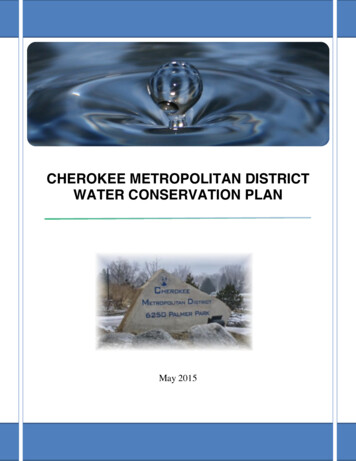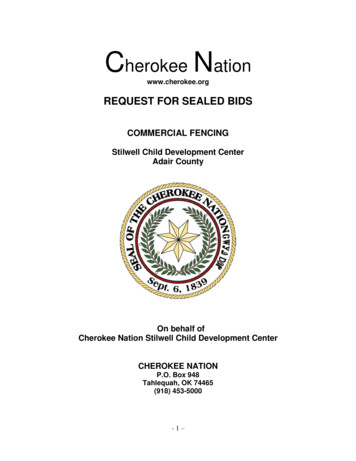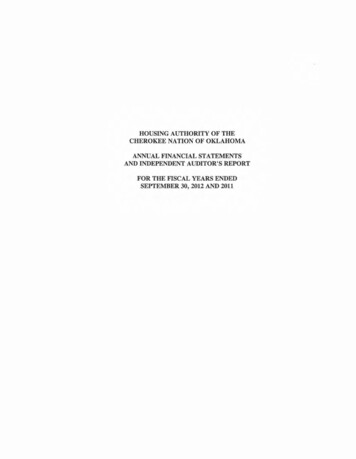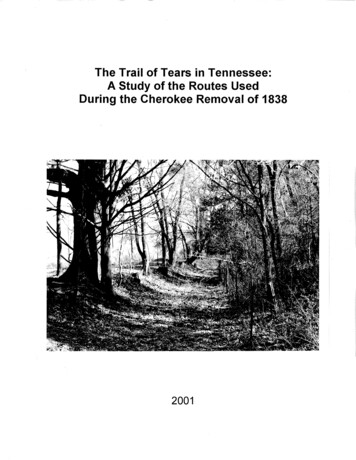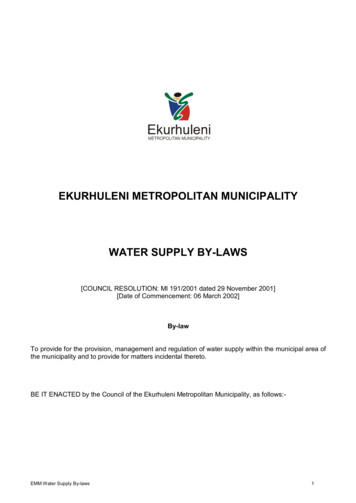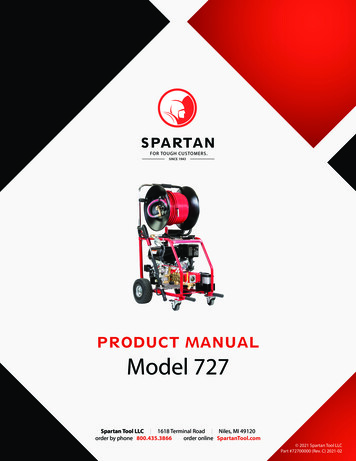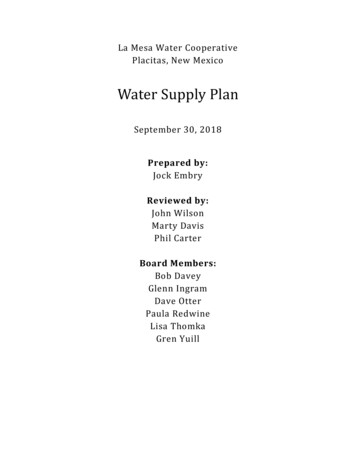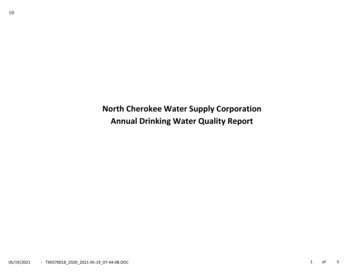
Transcription
10North Cherokee Water Supply CorporationAnnual Drinking Water Quality Report05/19/2021- TX0370018 2020 2021-05-19 07-44-08.DOC1of5
2020 Consumer Confidence Report for Public Water System NORTH CHEROKEE WSCThis is your water quality report for January 1 to December 31, 2020For more information regarding this report contact:NORTH CHEROKEE WSC provides surface water and ground water from [LakeJacksonville/ Carrizo-Wilcox aquifer] located in [Cherokee County]Name - Scott AlexanderPhone - 903-894-3385North Cherokee WSC has a regularly scheduled board meeting the secondMonday of each month at 7:00 p.m. at the corner of US 69 and FM 177.Este reporte incluye información importante sobre el agua para tomar. Para asistencia en español, favor dellamar al telefono (800) 426-4791.Definitions and AbbreviationsDefinitions and AbbreviationsThe following tables contain scientific terms and measures, some of which may require explanation.Action Level:The concentration of a contaminant which, if exceeded, triggers treatment or other requirements which a water system must follow.Avg:Regulatory compliance with some MCLs are based on running annual average of monthly samples.Level 1 Assessment:A Level 1 assessment is a study of the water system to identify potential problems and determine (if possible) why total coliform bacteria have been found in ourwater system.Level 2 Assessment:A Level 2 assessment is a very detailed study of the water system to identify potential problems and determine (if possible) why an E. coli MCL violation has occurredand/or why total coliform bacteria have been found in our water system on multiple occasions.Maximum Contaminant Level or MCL:The highest level of a contaminant that is allowed in drinking water. MCLs are set as close to the MCLGs as feasible using the best available treatment technology.Maximum Contaminant Level Goal or MCLG:The level of a contaminant in drinking water below which there is no known or expected risk to health. MCLGs allow for a margin of safety.Maximum residual disinfectant level or MRDL:The highest level of a disinfectant allowed in drinking water. There is convincing evidence that addition of a disinfectant is necessary for control of microbialcontaminants.Maximum residual disinfectant level goal or MRDLG:The level of a drinking water disinfectant below which there is no known or expected risk to health. MRDLGs do not reflect the benefits of the use of disinfectants tocontrol microbial contaminants.MFLmillion fibers per liter (a measure of asbestos)mrem:millirems per year (a measure of radiation absorbed by the body)na:not applicable.NTUnephelometric turbidity units (a measure of turbidity)pCi/Lpicocuries per liter (a measure of radioactivity)05/19/2021- TX0370018 2020 2021-05-19 07-44-08.DOC2of5
Definitions and Abbreviationsppb:micrograms per liter or parts per billionppm:milligrams per liter or parts per millionppqparts per quadrillion, or picograms per liter (pg/L)pptparts per trillion, or nanograms per liter (ng/L)Treatment Technique or TT:A required process intended to reduce the level of a contaminant in drinking water.Information about your Drinking WaterThe sources of drinking water (both tap water and bottled water) include rivers, lakes, streams, ponds, reservoirs, springs, and wells. As water travels over the surface of the landor through the ground, it dissolves naturally-occurring minerals and, in some cases, radioactive material, and can pick up substances resulting from the presence of animals orfrom human activity.Drinking water, including bottled water, may reasonably be expected to contain at least small amounts of some contaminants. The presence of contaminants does notnecessarily indicate that water poses a health risk. More information about contaminants and potential health effects can be obtained by calling the EPAs Safe Drinking WaterHotline at (800) 426-4791.Contaminants that may be present in source water include:- Microbial contaminants, such as viruses and bacteria, which may come from sewage treatment plants, septic systems, agricultural livestock operations, and wildlife.- Inorganic contaminants, such as salts and metals, which can be naturally-occurring or result from urban storm water runoff, industrial or domestic wastewater discharges, oiland gas production, mining, or farming.- Pesticides and herbicides, which may come from a variety of sources such as agriculture, urban storm water runoff, and residential uses.- Organic chemical contaminants, including synthetic and volatile organic chemicals, which are by-products of industrial processes and petroleum production, and can also comefrom gas stations, urban storm water runoff, and septic systems.- Radioactive contaminants, which can be naturally-occurring or be the result of oil and gas production and mining activities.In order to ensure that tap water is safe to drink, EPA prescribes regulations which limit the amount of certain contaminants in water provided by public water systems. FDAregulations establish limits for contaminants in bottled water which must provide the same protection for public health.Contaminants may be found in drinking water that may cause taste, color, or odor problems. These types of problems are not necessarily causes for health concerns. For moreinformation on taste, odor, or color of drinking water, please contact the system's business office.You may be more vulnerable than the general population to certain microbial contaminants, such as Cryptosporidium, in drinking water. Infants, some elderly, orimmunocompromised persons such as those undergoing chemotherapy for cancer; persons who have undergone organ transplants; those who are undergoing treatment withsteroids; and people with HIV/AIDS or other immune system disorders, can be particularly at risk from infections. You should seek advice about drinking water from yourphysician or health care providers. Additional guidelines on appropriate means to lessen the risk of infection by Cryptosporidium are available from the Safe Drinking WaterHotline (800-426-4791).05/19/2021- TX0370018 2020 2021-05-19 07-44-08.DOC3of5
If present, elevated levels of lead can cause serious health problems, especially for pregnant women and young children. Lead in drinking water is primarily from materials andcomponents associated with service lines and home plumbing. We are responsible for providing high quality drinking water, but we cannot control the variety of materials usedin plumbing components. When your water has been sitting for several hours, you can minimize the potential for lead exposure by flushing your tap for 30 seconds to 2 minutesbefore using water for drinking or cooking. If you are concerned about lead in your water, you may wish to have your water tested. Information on lead in drinking water, testingmethods, and steps you can take to minimize exposure is available from the Safe Drinking Water Hotline or at http://www.epa.gov/safewater/lead.Information about Source WaterNORTH CHEROKEE WSC purchases water from CITY OF JACKSONVILLE. CITY OF JACKSONVILLE provides purchase surface water from [Lake Jacksonville] located in [Cherokee County].City of Jacksonville ResultsNORTH CHEROKEE WSC purchases water from CITY OF JACKSONVILLE. CITY OF JACKSONVILLE provides purchase ground water from [Carrizo-Wilcox aquifer] located in [Cherokee County].No Source Water Assessment for your drinking water source(s) has been conducted by the TCEQ for your water system. The report describes the susceptibility and the types of constituents that may come into contact withyour drinking water source based on human activities and natural conditions. The information in this assessment allows us to focus our source water protection strategies.05/19/2021- TX0370018 2020 2021-05-19 07-44-08.DOC4of5
2020 Water Quality Test ResultsLead and CopperDate SampledMCLGAction Level (AL)90th Percentile# Sites Over d9/17/201901500ppbNLikely Source of ContaminationErosion of natural deposits; Leaching from woodpreservatives; Corrosion of household plumbingsystems.Corrosion of household plumbing systems;Erosion of natural depositsDisinfection By-ProductsCollection DateHighest LevelDetectedRange of IndividualSamplesMCLGMCLUnitsViolationLikely Source of ContaminationHaloacetic Acids (HAA5)20203112.6 – 63.5No goal for thetotal60ppbNBy-product of drinking water disinfection.ppbNBy-product of drinking water disinfection.*The value in the Highest Level or Average Detected column is the highest average of all HAA5 sample results collected at a location over aTotal Trihalomethanes (TTHM)20206822.2 – 137No goal for thetotal80*The value in the Highest Level or Average Detected column is the highest average of all TTHM sample results collected at a location over a yearInorganic ContaminantsCollection DateHighest LevelDetectedRange of 20190.0260.026 – 0.02622ppmNDischarge of drilling wastes; Discharge from metalrefineries; Erosion of natural deposits.Fluoride06/06/20190.2970.297 – 0.29744.0ppmNErosion of natural deposits; Water additive whichpromotes strong teeth; Discharge from fertilizer andaluminum factories.20200.03460.0225 – 0.03461010ppmNRunoff from fertilizer use; Leaching from septic tanks,sewage; Erosion of natural deposits.Nitrate [measured as Nitrogen]05/19/2021- TX0370018 2020 2021-05-19 07-44-08.DOCLikely Source of Contamination4of5
Disinfectant ResidualDisinfectant ResidualYearAverage LevelRange of LevelsDetectedMRDLMRDLGUnit of MeasureViolation (Y/N)Chlorine20201.27.5-2.1144ppmN05/19/2021- TX0370018 2020 2021-05-19 07-44-08.DOCSource in Drinking WaterWater additive used to control microbes.5of5
2020 Consumer Confidence Report for Public Water System NORTH CHEROKEE WSC This is your water quality report for January 1 to December 31, 2020 For more information regarding this report contact: NORTH CHEROKEE WSC provides surface water and ground water from [Lake Jacksonville/ Carrizo-Wilcox aquifer] located in [Cherokee County]
